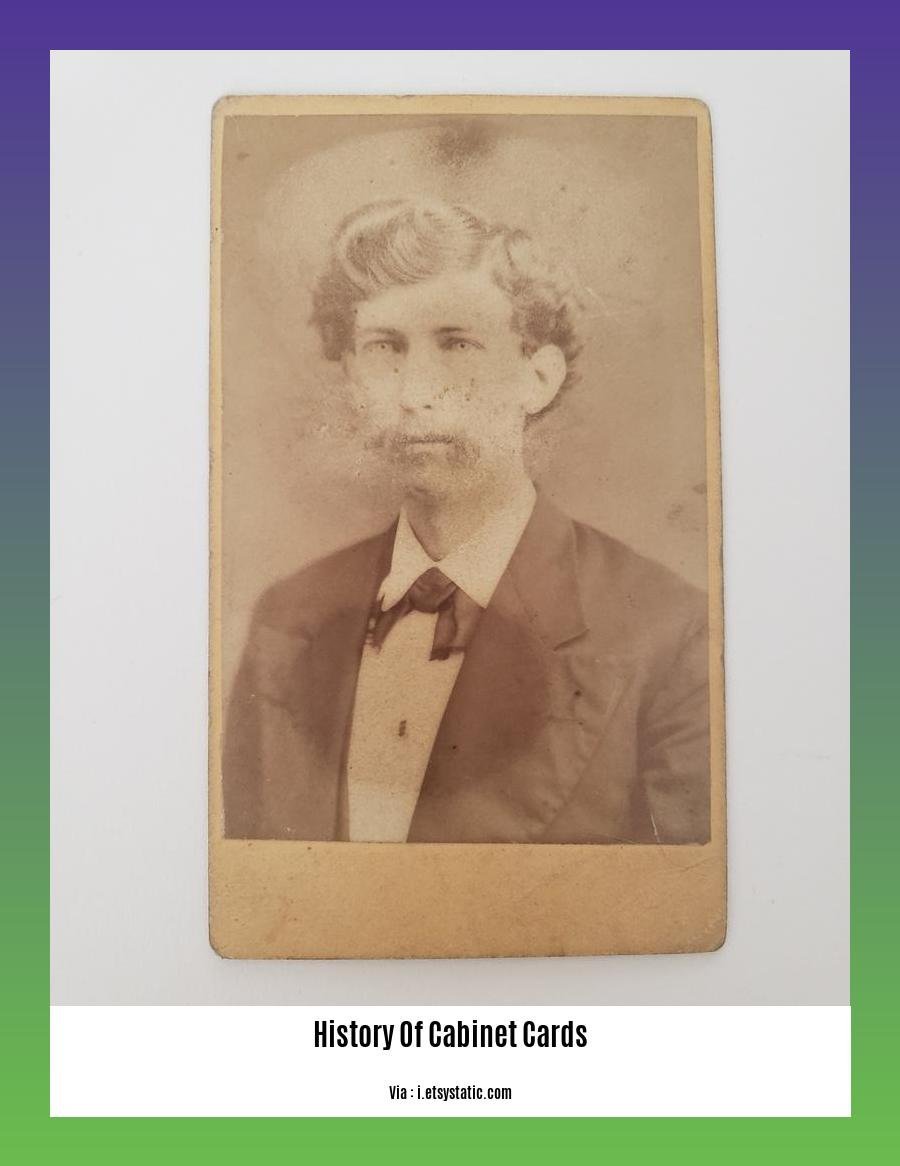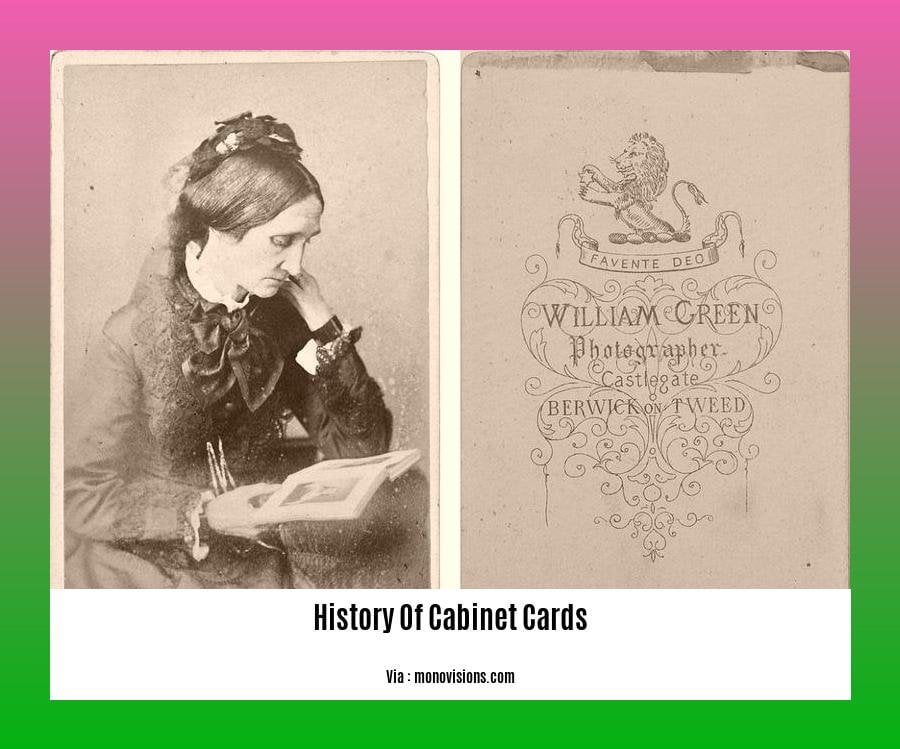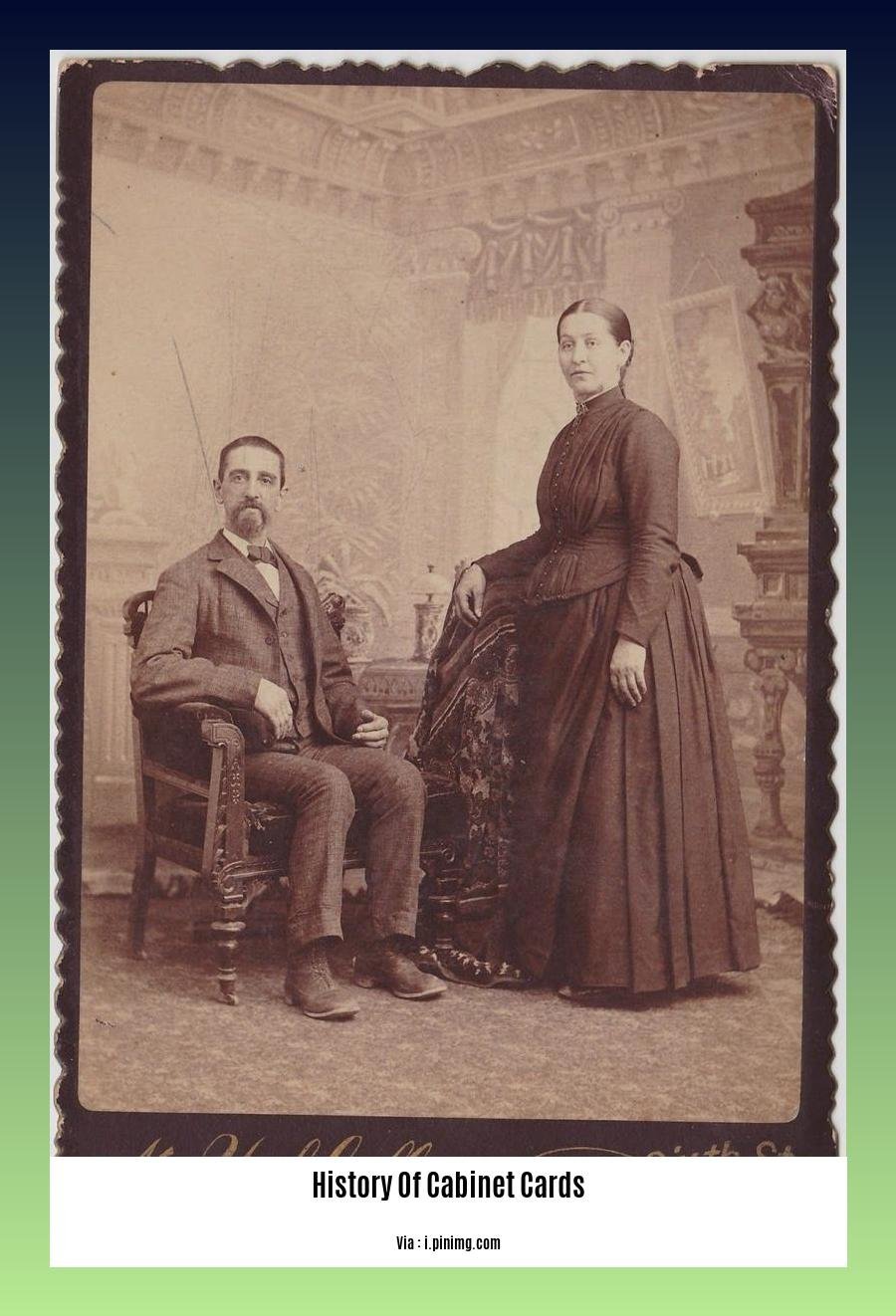[A History of Cabinet Cards: Capturing Memories in the 19th Century] – In the tapestry of 19th-century American culture, the advent of cabinet cards marked a significant milestone in the realm of photography. As mass-produced photographic portraits, they revolutionized the way individuals and families preserved their memories. Their ubiquitous presence in homes and public spaces reflected the pervasive desire for self-expression, social connection, and the commemoration of life’s milestones.
Key Takeaways:
- Cabinet cards were a popular photography format from the late 19th to early 20th centuries.
- Introduced in England in 1863, they became widespread in the US from 1866.
- They consisted of photographic prints mounted on 4 ¼ x 6 ½ inch cardstock.
- Cabinet cards were commonly used for family portraits and displayed in parlors.
- They continued to be produced until the early 1900s.
History of Cabinet Cards

From the late 1800s to the early 1900s, History Of Cabinet Cards was all the rage for capturing and preserving priceless memories. These ubiquitous photographic relics played a pivotal role in shaping how societies documented their past, leaving an indelible mark on our cultural heritage.
Origins and Innovations
The History Of Cabinet Cards can be traced back to 1863 London, where they were first introduced. By 1866, they had made their way across the Atlantic, captivating American society. Cabinet cards consisted of photographic prints meticulously mounted on cardstock, measuring precisely 4 ¼ x 6 ½ inches. This standardized format allowed for easy storage and display in Victorian parlors.
Social Conventions and Cultural Impact
History Of Cabinet Cards were particularly popular for family portraits. Families would often commission professional photographers to capture cherished moments, such as weddings, anniversaries, and graduations. These images served as a tangible connection to loved ones, especially in an era where long-distance communication was limited.
Cabinet cards also played a significant role in shaping cultural norms. They were often used as calling cards, exchanged during social visits and formal events. The images on these cards offered a glimpse into the lives and aspirations of individuals, providing valuable insights into the social customs of the time.
Technical Advancements
History Of Cabinet Cards showcased the technical advancements of the late 19th century. They were typically produced using the wet collodion process, which involved coating a glass plate with a light-sensitive emulsion and then exposing it to light. The resulting negative was then used to create multiple positive prints, which were then mounted on cardstock.
This innovative technique allowed for the mass production of cabinet cards, making them accessible to a wider audience. They became an affordable way for families to capture their memories and share them with others.
Legacy and Significance
History Of Cabinet Cards continued to be produced until the early 1900s, when they were gradually replaced by more modern photographic formats. However, their legacy remains intact, as they offer a fascinating window into the social, cultural, and technological landscape of the Victorian era. Today, cabinet cards are highly prized by collectors and historians, serving as valuable artifacts that tell the stories of our ancestors.
Learn more about the fascinating story of Cabinet Making in our comprehensive resource on the History Of Cabinet Making. Delve into the evolution of Cabinet design and craftsmanship throughout the ages.
Discover the origins and evolution of the Cabinet in our article on the History Of Cabinets. Explore the diverse styles and functions of Cabinets through history.
Uncover the captivating history of Cabinet Departments and their roles in shaping government and society.
The Physical Characteristics of Cabinet Cards

Imagine a photograph with a distinguished presence, mounted on a sturdy cardboard backing, exuding an aura of nostalgia and charm. This is a cabinet card, a ubiquitous photographic format that captured the essence of the 19th century.
Key Takeaways:
- Cabinet cards measure approximately 6.5 x 4.25 inches, providing ample space for detailed portraits.
- Mounted on rigid cardboard, they offered durability and protection for the precious images.
- The front of the cabinet card often featured the photographer’s studio logo or imprint, adding a professional touch.
- The reverse side was often adorned with intricate designs or advertising, creating a personalized keepsake.
- Cabinet cards allowed for mass production and standardization, making photography accessible to a wider audience.
As we delve into the captivating world of cabinet cards, let’s explore their unique physical attributes that set them apart from other photographic formats. Their size, mounting, front design, and reverse decoration contribute to their distinct character and historical significance.
Size
Cabinet cards adhere to a standardized size of 6.5 x 4.25 inches. This larger format, compared to the smaller carte de visite, allowed for more detailed portraits and group photographs. The ample size provided photographers with a canvas to capture facial expressions, clothing, and other details, creating a rich visual record of the era.
Mounting
The distinguishing feature of cabinet cards lies in their rigid cardboard mount. The photograph is securely attached to the cardboard backing, providing both protection and stability. Unlike loose prints, cabinet cards could be easily stored, displayed, or shared. The sturdy mount allowed for handling and preservation, ensuring that these precious images could withstand the passage of time.
Front Design
The front of the cabinet card typically features the photograph itself, often surrounded by an ornate border or decorative design. This border served as a frame, highlighting the image and adding a touch of elegance. Some photographers also included their studio logo or imprint on the front, providing identification and a sense of professionalism.
Reverse Decoration
Flipping the cabinet card over reveals a world of intricate designs and advertising. The reverse side was often adorned with elaborate patterns, embossing, or handwritten notes. Photographers used this space to showcase their creativity and promote their services. Some cabinet cards also featured advertising for local businesses, adding a glimpse into the commercial landscape of the 19th century.
Sources:
Technological Innovations and Production
Cabinet cards, introduced in the 1860s, were a significant advancement in photography, offering several key advantages:
- Standardization: Cabinet cards were produced in a standardized size (6.5 x 4.25 inches), making them easy to store and display in albums or frames.
- Mass Production: Technological innovations in the wet collodion process allowed for the mass production of cabinet cards, making them widely accessible and affordable.
- Intricate Designs: The backs of cabinet cards often featured intricate designs, showcasing the skill and artistry of photographers.
These technological innovations and production advancements played a crucial role in the popularity and accessibility of cabinet cards, shaping how people captured and shared their memories in the 19th century.
Key Takeaways:
- Cabinet cards introduced standardization and mass production in photography.
- Intricate designs showcased the artistry of photographers.
- These advancements made cabinet cards widely accessible and popular.
Sources:
Decline and Impact
In the realm of photography, the decline and impact of cabinet cards unfolded in the late 19th century. While they once reigned supreme as a preferred format for capturing memories, the emergence of new technologies and changing societal norms led to their gradual fade.
The Rise and Fall of Cabinet Cards
Cabinet cards, introduced in the 1860s, soared in popularity due to their larger size and impressive presentation compared to their predecessors, the carte de visite. They became a ubiquitous choice for formal portraits, gracing mantelpieces and family albums alike.
However, the advent of smaller cameras and the popularization of snapshot photography in the late 1880s posed a significant challenge to cabinet cards. These new formats offered ease of use and spontaneity, appealing to a wider audience seeking a more casual approach to photography.
The Legacy of Cabinet Cards
Despite their eventual displacement, cabinet cards left an enduring mark on photography. Their standardized format and mass production paved the way for future advancements, influencing the development of postcards and other accessible formats. Today, they are prized by collectors and historians as tangible artifacts that capture the cultural and social mores of the Victorian era.
Key Takeaways:
- The rise of snapshot photography and smaller cameras in the late 1880s challenged the popularity of cabinet cards.
- Cabinet cards played a significant role in shaping the development of photography, influencing the standardization and accessibility of photographic formats.
- Despite their decline, cabinet cards remain valuable historical artifacts that provide insights into the culture and society of the Victorian era.
Sources:
– The Return of Cabinet Cards
– Unveiling the Beauty: Exploring 19th Century Cabinet Cards
FAQ
Q1: When were cabinet cards first introduced?
A1: Cabinet cards were first introduced in 1860, although they became popular for portraits a few years later.
Q2: What was the primary use of cabinet cards?
A2: Cabinet cards were primarily used for family portraits, which could be displayed in parlors.
Q3: Which format did cabinet cards replace?
A3: Cabinet cards replaced the smaller carte de visite format, which was also used for portraiture.
Q4: Why did the popularity of cabinet cards decline?
A4: The popularity of cabinet cards declined in the 1890s, as snapshot and personal photography became more widespread.
Q5: What were the primary differences between cabinet cards and carte de visite?
A5: Cabinet cards were larger (4 ¼ x 6 ½ inches) than carte de visite (2.5 x 4.5 inches) and were typically mounted on cardstock.
- How many weeks is 40 days: Quick Conversion Guide for Accurate Results - March 31, 2025
- How many feet is 300 meters? 984 Feet: Understand Length Conversions Easily - March 31, 2025
- Senior at What Age: Benefits & Eligibility Guide - March 29, 2025
















